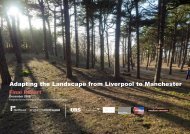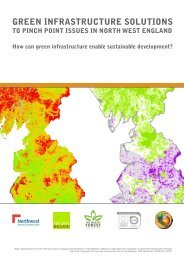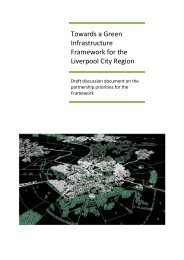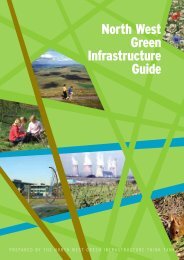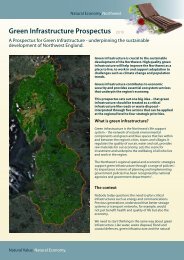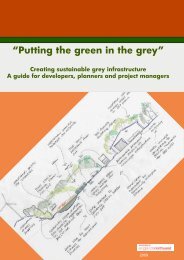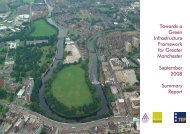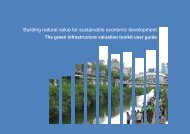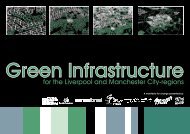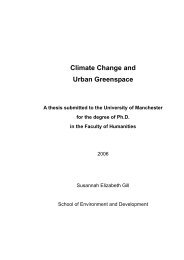a Public Benefit Mapping Project - Green Infrastructure North West
a Public Benefit Mapping Project - Green Infrastructure North West
a Public Benefit Mapping Project - Green Infrastructure North West
- No tags were found...
Create successful ePaper yourself
Turn your PDF publications into a flip-book with our unique Google optimized e-Paper software.
1.0INTRODUCTION1.1 BACKGROUND TO THE STUDY1.1.1 In 2005 the East Midlands Regional Assembly(EMRA)and a number of its regional partners 1 commissioned a scopingstudy of <strong>Green</strong> <strong>Infrastructure</strong> (GI) in the East Midlands. Thisstudy investigated the potential for mapping the functionality ofopen spaces in a number of study areas across the region.These study areas were located in existing economic and socialregeneration initiative areas.1.1.2 The purpose of the study was to identify whether GIprovision and deficit could be mapped and assessed spatially.Further, it proposed to identify a technique for assessing themultiple-functionality of greenspaces in their existingcondition, and the potential to derive additional functionalitythrough management interventions.1.1.3 The study has achieved significant success in embeddingthe concept of GI as a component in successful regenerationand as an integral part of “Environmental <strong>Infrastructure</strong>” -central to the region’s strategy for growth. The study has alsosucceeded in promoting the concept of multifunctional use ofgreen spaces and green networks.1.1.4 However, the EMRA Environment Group recognised thatit is important to prioritise delivery of GI in those areas where itis most needed. Whilst the pilot-study areas will undoubtedly begood examples of where GI provision will be beneficial, theremay be other areas in the region with significant deficits in GIand/or significant needs for the benefits that GI can bring.1.1.5 The Environment Group thus commissioned this, theEast Midlands <strong>Public</strong> <strong>Benefit</strong> <strong>Mapping</strong> <strong>Project</strong>, as a secondstage to that earlier work, examining whether the <strong>Public</strong><strong>Benefit</strong> Recording System (PBRS) technique could be appliedto the region to identify areas of greatest public benefit frominvestments in GI.1.2 GREEN INFRASTRUCTURE – DEFINITION AND BENEFITS1.2.1 <strong>Green</strong> <strong>Infrastructure</strong> (GI) is a term which has evolved inrecent years within Governmental social and regenerationpolicies to describe the network of greenspaces and naturalelements that intersperse and connect our cities, villages andtowns. In urban situations GI complements and balances thebuilt environment; in rural settings it provides a framework forsustainable economies and biodiversity; in-between it linkstown and country and interconnects wider environmentalprocesses. GI is an holistic approach to viewing the natural environmentwhich acknowledges the multiple benefits and vitalfunctions it provides for the economy, wildlife, local people,communities and cultural assets alike.1.2.2 Governmental commitment to economic and populationgrowth in the South East and South Midlands is accompanied bya commitment to infrastructure improvements including GI.There are examples from Milton Keynes and <strong>North</strong>amptonshireof direct Government funding intervention to support GI creationand encourage GI benefits from planning gain.1.2.3 This is of course not a new trend. Initiatives such as theCommunity Forests and the National Forest have shown howformerly private or degraded land can be regenerated andbrought into the public domain so that greenspaces canperform many more functions of benefit to neighbourhoods.Through such contributions to healthier and sustainablelifestyles it is increasingly being recognised as a key factorcentral to the agendas of sustainable communities,development and growth.1.2.4 There are numerous national policy priorities that maybe delivered through GI 2 ., and at the regional level it is nowfirmly recognised as being a core component of Regional SpatialStrategies, and is featured within Regional Rural DevelopmentFrameworks and Economic Strategies. It is implicitly recognisedin numerous other regional level strategy and policy documentsconcerning planning, health, sport, biodiversity, culture etc.1.2.5 There is now a need for strategic overview of where themost significant public benefit can be secured through investmentin GI. Given a situation of limited resources and a desireto maximise the cost cutting benefits of public investment;there is an over-riding need in spatial strategy to identify areas;• which are undergoing social or environmental deficit(a ‘needs’ focussed approach) and/or;• where the sustainable development opportunitiesarising from a high quality environment can be captured(an ‘opportunity’ focussed approach).1.2.6 There is also a need for this to be firmly evidence-basedand to be driven by integrated sustainable objectives –combining social, environmental and economic outcomes.1 The Countryside Agency, Environment Agency, The National Trust, East Midlands Development Agency, English Nature, English Heritage, Groundwork,Defra, Sport England, Government Office for the East Midlands, The Wildlife Trusts and the Institute for Sustainable Development in Business.5



